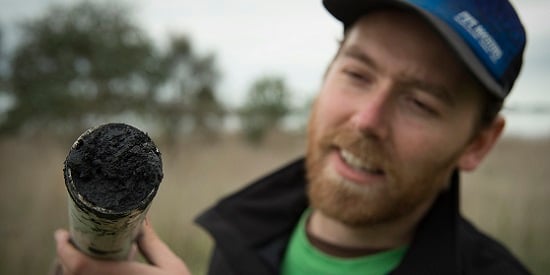New study reveals value of tidal marshes in fight against climate change
Media releaseThe world's largest and most comprehensive study of Australian tidal marshes has revealed they are worth more than $7 billion to the national economy and provided much-needed benchmark data that will guide future management of these vital blue carbon sinks.
Dozens of scientists around Australia with expertise in blue carbon joined forces for the three-year study led by the CSIRO, collecting and analysing 323 soil samples from tidal marshes in temperate locations around the coast.
The samples and associated data were co-ordinated by Deakin University’s Blue Carbon Lab with the subsequent report published today in the prestigious Scientific Reports journal.
Blue Carbon Lab Director Dr Peter Macreadie said scientists had long suspected that Australia had a lot of blue carbon in its tidal marshes but the amount hadn’t been quantified or valued until now.
“The study collected and analysed new data from 323 sites and 11 observations sourced from existing literature, compared to a recent global review of tidal marshes which used only 143 samples, making it the largest study of its kind to date,” Dr Macreadie said.
“From our data, we estimate that Australia’s 1.4 million hectares of tidal marshes contain an estimated 212 million tonnes of organic carbon with a CO2 equivalent value of $USD7.19 billion.
”Importantly, the total value of these blue carbon ecosystems far surpasses this figure due to the other ecosystem services they provide such as nutrient filtration, flood mitigation, nursery grounds for fisheries, and biodiversity.”
Dr Macreadie said that while they were often unappreciated by the Australian public, wetlands – which include tidal marshes (often referred to as salt marshes), mangroves and seagrasses – are known to store carbon in the ground for thousands of years.
“We’ve been trying to find systems that do a better job at carbon sequestration than trees and forests and that’s when we stumbled across wetland systems which, on average, capture and store carbon in soils 40 times faster than tropical rainforests like the Amazon,” Dr Macreadie said.
The report’s co-author, Deakin University PhD student Quinn Ollivier, said that calculating and applying a dollar value to tidal marshes reinforced their importance and could potentially assist governments and resource managers in future decision making around the planning and management of tidal marshes.
“It’s about trying to quantify nature and we’re really fortunate that of all the different ecosystem services that exist in the world, carbon happens to be one that we have a price on,” Mr Ollivier said.
“When we think about future management of these ecosystems – some of which are degraded and being built upon or affected by human activity – it allows us to put into context their value in carbon sequestration.
“For example, there might be a proposal to build new housing on a tidal marsh and we can accurately measure the value to the community of that project against the value of tidal marsh carbon sequestration and potentially other services like biodiversity, habitat for birds, fisheries values, coastal protection, and the like.”
Dr Macreadie said the study revealed two opportunities for improving the management of tidal marshes.
“Firstly, we can choose to look at the existing and historic extent of tidal marshes and restore, protect and conserve what we’ve already got,” Dr Macreadie said.
“Then there’s the option of creating salt marshes in coastal areas where they’ve never existed before and that’s because sea levels are rising – they’ve risen about 20cm in the past 100 years, on average.
“For example, there’s a lot of low lying farmland around Australia that is vulnerable to sea level rise. Our natural reaction is to put up walls and defend against sea level rise, but as the price of carbon increases there will come an opportunity for farmers to farm carbon by letting those lands be flooded by salty seas to encourage the growth of salt marshes.
“I can definitely see a growing future for farming carbon through salt marshes and mangroves.”
Australian and international partners in the CSIRO-led project included The University of Queensland, Edith Cowan University, Macquarie University, University of Technology Sydney, Griffith University, the University of Western Australia, and the King Abdullah University of Science and Technology (KAUST) in Saudi Arabia.
Share this story

